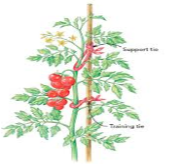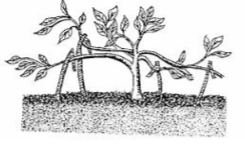INSTRUCTIONS
- Answer all the questions in the spaces provided
- Define the following terms.
- Seed dressing. (1mk
- Chitting (1mk)
- The diagram below represents a field management practice carried out on crops.
- Identify the above practice (1mk)
- Name one crop the practice is commonly practiced on (1mk)
- Give two reasons for carrying out the above practice (2mks)
- List four human factors that influence agriculture (2mks)
- Give four reasons for treating water for use on the farm (2mks)
- State four precautions that should be observed when using workshop tools (2mks)
- Give four reasons why burning is discouraged as a method of land clearing (2mks)
- Name four practices that enhance minimum tillage (2mks)
- Give two sources of underground water (1mks)
- State four characteristics of a fertile soil (2mks)
- Name four breeds of dairy goats (2mks)
- Name two types of Inventory records (1mk)
- List four symptoms of Nitrogen deficiency in plants (2mks)
- Name two vegetative materials used to propagate pineapples (1mk)
- Outline four factors considered when selecting a nursery site (2mks)
- State four characteristics of a good grain store (2mks)
- Study the diagram below and answer the following questions.
- Identify the practice above. (1mk)
- State two reasons for carrying out the practice above. (2mks)
- The diagram below shows an experiment set up using soil types G, H and J. Observations were made after 24hrs. Study the diagram and answer questions that follow.
- What is the experiment above designed to study? (1 mk)
- Name the three soil types G, H and J. (3 mks)
- Explain how the farmer can improve soil type G. (1 mks)
-
- State the factors that determine the stage and time of harvesting crops. (5mks)
- state four methods of harvesting crops (4mks)
- Outline 4 importance of pruning in coffee production. (4mks)
MARKING SCHEME
- Define the following terms.
- Seed dressing. (1mk)
- This is the coating of seeds with fungicides or an insecticide or a combination of the two chemicals
- Chitting
- practice where the selected seed potatoes ‘setts’ which are used as planting materials are sprouted before planting to break their dormancy (1mk)
- Seed dressing. (1mk)
- The diagram below represents a field management practice carried out on crops.
- Identify the above practice (1mk)
- staking
- Name one crop the practice is commonly practiced on (1mk)
- tomatoes
- Give two reasons for carrying out the above practice (2mks)
- Obtain clean fruits
- Protect the fruits from soil borne best and diseases
- Easy harvesting
- Identify the above practice (1mk)
- List for human factors that influence agriculture (2mks)
- Level of education and technology:
- Human health/HIV-AIDS:
- Economy
- Government Policy:
- Transport and communication:
- Cultural practices and religious beliefs:
- Market forces:
- Give four reasons for treating water for use on the farm (2mks)
- To kill disease causing microorganisms such as cholera and typhoid bacteria that thrive in dirty water.
- To remove chemical impurities such as excess fluoride which may be harmful to human beings.
- To remove smells and bad taste.
- To remove sediments of solid particles such as soil, sand and sticks.
- State four precautions that should be observed when using workshop tools (2mks)
- Use tools for the right work.
- Proper handling when using tools or equipment.
- Clean and oil tools after work.
- Keep tools in there right place.
- Replace and repair worn-out parts
- Sharpen cutting or digging edges
- Grease moving parts to reduce friction
- Use safety devices in the workshop to reduce accidents and breakages
- Give four reasons why burning is discouraged as a method of land clearing (2mks)
- Leads to loss of organic matter,
- Kills soil organisms
- Destroys soil structure and plant nutrients.
- Name four practices that enhance minimum tillage (2mks)
- Use of herbicides.
- Mulching and cover-cropping.
- Timely operations to prevent weed infestation.
- Strip cultivation.
- Uprooting and slashing of weeds.
- Give two sources of underground water (1mks)
- Springs,
- Wells
- Boreholes.
- State four characteristics of a fertile soil (2mks)
- Good depth - Good soils give roots greater volume to obtain plant nutrients and provide strong anchorage.
- Good aeration - for the respiration of plant roots and use by soil organisms.
- Good water holding capacity - ensures provision of adequate water for plant growth.
- Proper drainage - ensures provision of adequate air for plant growth.
- Correct soil pH - different crops have different soil pH requirements.
- Adequate nutrients supply - it should supply the required nutrients in the correct amounts and in a form available to plants.
- Free from excessive infestation of soil borne pests and diseases.
- Name four breeds of dairy goats (2mks)
- Anglo-Nubian
- Jumnapari
- Toggenburg
- Saanen
- Name two types of Inventory records (1mk)
- permanent Goods Inventory
- Consumable Goods Inventory
- List four symptoms of Nitrogen deficiency in plants (2mks)
- Yellowing of the leaves/chlorosis.
- Stunted growth.
- Premature ripening.
- Premature shedding of the leaves.
- Light seeds.
- Name two vegetative materials used to propagate pineapples (1mk)
- Crowns and slips
- Suckers
- Outline four factors considered when selecting a nursery site (2mks)
- Nearness to the water source.
- Type of soil.-should be well drained, deep and fertile, preferably loam soil.
- Topography.-it should be situated on a gentle slope to prevent flooding and erosion through surface run-off.
- Previous cropping.-to avoid build up of pests and diseases associated with particular plant families, consider the preceding crops.
- Security.-select a site that is protected from theft and destruction by animals.
- Protection against strong winds and heat of the sun.-select a sheltered place. i.e. to avoid excessive evapotranspiration and uprooting seedlings.
- State four characteristics of a good grain store (2mks)
- It should be clean.
- It should be well ventilated.
- It should be raised from the ground to prevent damp conditions.
- It should be dry.
- It should be strong to hold crop produce.
- It should be easy to clean.
- It should be vermin-proof.
- It should be secure from theft.
- It should be treated against pests such as weevils.
- Study the diagram below and answer the following questions.
- Identify the practice above. (1mk)
- Formative pruning
- State two reasons for carrying out the practice above. (2mks)
- Formation of flat pluking table
- Facilitate lateral growth
- Identify the practice above. (1mk)
- The diagram below shows an experiment set up using soil types G, H and J. Observations were made after 24hrs. Study the diagram and answer questions that follow.
- What is the experiment above designed to study? (1 mk)
- Drainage of different soils
- Water holding capacity
- Name the three soil types G, H and J. (3 mks)
- H - loam soil
- G - sandy soils
- J - clay soil
- Explain how the farmer can improve soil type G. (1 mks)
- Adding organic matter
- Cover crops
- Mulching
- Crop rotation
- Terracing and Contouring
- Soil Testing and Nutrient management
- What is the experiment above designed to study? (1 mk)
-
- State the factors that determine the stage and time of harvesting crops.
- Stage of maturity of the crops.
- Use of the crop.
- Tastes and preferences of consumers.
- Weather conditions, hence liability to spoilage.
- Moisture (5mks)
- state four methods of harvesting crops 4mks
- Harvesting crops by hand (picking)
- Harvesting Crops with Hand Tools (reaping, digging)
- Harvesting Crops with Machinery Harvesting rigs, mowers, combine)
- Outline 4 importance of pruning in coffee production. (4mks)
- To remove old, unproductive or diseased, damaged parts of the plant.
- To control crop leave ratio hence avoiding overbearing.
- To control diseases and pests for example antestia bugs in coffee.
- To facilitate other operations such as spraying, picking and seeding.
- To reduce wastage of chemicals applied on the crop.
- To remove branches that interfere with traffic, telephone lines and view.
- Open up the plant to allow free air circulation and exposure of leaves to sunlight.
- State the factors that determine the stage and time of harvesting crops.
Join our whatsapp group for latest updates
Tap Here to Download for 50/-
Get on WhatsApp for 50/-
Download Agriculture Questions and Answers - Form 2 Mid Term 2 Exams 2023.
Tap Here to Download for 50/-
Get on WhatsApp for 50/-
Why download?
- ✔ To read offline at any time.
- ✔ To Print at your convenience
- ✔ Share Easily with Friends / Students




